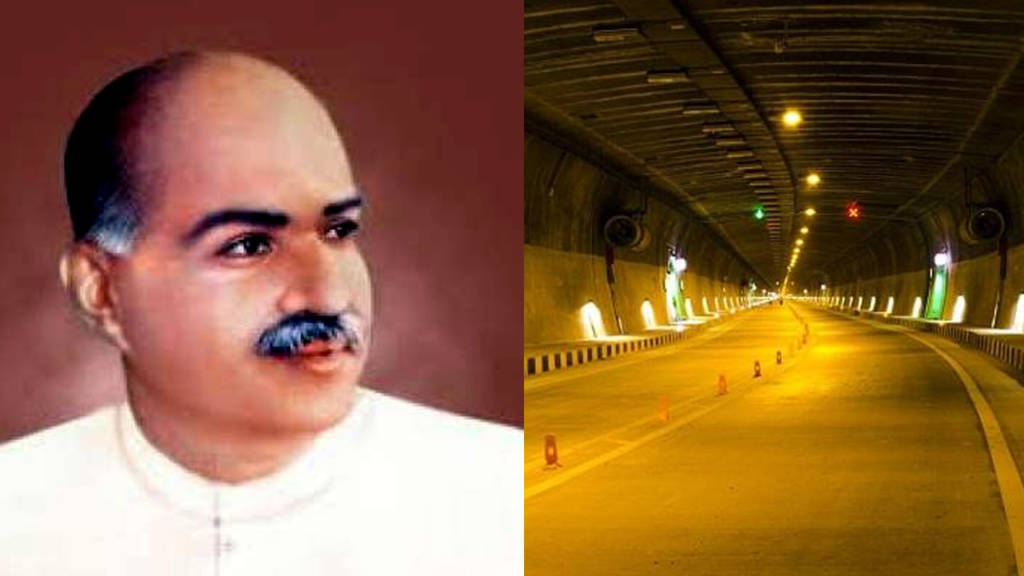Jahan hue balidaan Mukherjee, wo Kashmir humara hai
Jo Kashmir humara hai wo saara ka saara hai
In what can be described as a fitting tribute to the Jansangh founder, Dr Shyama Prasad Mukherjee, who had fought a brave battle for complete integration of Jammu & Kashmir with India, India’s longest Chenani-Nashri tunnel that links Jammu with several major cities in the Kashmir valley is all set to be renamed after him.
Making the big announcement, Union Road, Transport and Highways Minister Nitin Gadkari tweeted, “Historic! Chenani- Nashri Tunnel on NH 44, in Jammu and Kashmir to be named after Dr. Shyama Prasad Mukherjee. This is our humble homage to Shyama Prasad Ji whose battle for Kashmir, One Nation One Flag has immensely contributed in national integration.”
Historic! Chenani- Nashri Tunnel on NH 44, in Jammu and Kashmir to be named after Dr. Shyama Prasad Mukherjee. This is our humble homage to Shyama Prasad Ji whose battle for Kashmir, One Nation One Flag has immensely contributed in national integration. #PragtiKaHighway
— Nitin Gadkari (मोदी का परिवार) (@nitin_gadkari) October 16, 2019
The 9.2 km long tunnel, which happens to be India’s longest tunnel, was dedicated to the country by PM Modi in 2017. The tunnel is one of the most important infrastructure projects in the state of Jammu & Kashmir virtually bringing the valley closer to the rest of India.
The tunnel has reduced the road distance between Srinagar and Jammu from 300 km to around 250 km. It has also led to all-weather connectivity between Jammu and Srinagar.
The tunnel links Chenani in Udhampur with Nashri in Ramban district reducing the distance between the two from 41 km to 9.2 km.
Moreover, it also bypasses the avalanche and landslide-prone spots on the highway.
The tunnel also boasts of impressive security features such as SOS call-boxes at every 150 metres, fire fighting system, surveillance, etc. There is a parallel escape tunnel with ‘Cross passages’ connecting at every 300 metres.
The tunnel connecting Chenani and Nashri is a huge strategic asset for India in the state. Along with the reduction in travel time for the civilian traffic, the tunnel ensures smooth movement of military convoys as well, making it easier to shift troops, equipment ammunition between Jammu and Srinagar.
With the tunnel bypassing snow and landslide-prone areas and ensuring all-weather connectivity, there is a definite advantage for India when it comes to quick military mobilisation in the strategically located region of Kashmir valley and adjoining areas.
This tunnel, therefore, lends strength to the Cold Start doctrine that envisages the swift deployment of troops along the western front in case a full-blown war arises.
The move of renaming tunnel after the Jansangh founder, Dr Shyama Prasad Mukherjee becomes much more important because it comes around two months after the Modi government abrogated Article 370 of the Constitution, thus getting rid of the controversial provision granting special status to the state of Jammu & Kashmir.
With this, the Modi government finally fulfilled Dr Mukherjee’s dream of full integration of the state with India.
It was Dr. Shyama Prasad Mukherjee who had first brought the issue of complete integration of Jammu and Kashmir, like any other state, into the mainstream.
After the merger of the state with the Union of India, Dr. Mukherjee had questioned the rationale behind having ‘Sadr-e-Riyasat’ instead of governors and a Prime Minister instead of Chief Ministers in the state of Jammu and Kashmir.
It was he who coined the popular slogan, “Ek desh mein do Vidhan, do Pradhan aur do Nishan nahi chalenge (There cannot be two Constitutions, two Prime Ministers and two flags in one nation)”.
Dr. Shyama Prasad Mukherjee exemplified fearlessness and courage by going against the permit rule during the days of the Nehru government whereby anyone travelling to the state of Jammu & Kashmir was required to obtain a permit.
His entourage decided to enter Jammu & Kashmir without any permit in order to ensure there was no sense of alienation in the border state.
Ultimately, he was arrested by the Sheikh Abdullah government in Jammu & Kashmir and passed away on June 23, 1953, in mysterious circumstances.
Later, in 2004, former Prime Minister, late Atal Bihari Vajpayee alleged that the Jammu & Kashmir government and the Nehru led government at the Centre had entered into a conspiracy as per which it had been decided that the Jansangh founder, Dr. Shyama Prasad Mukherjee would be allowed to enter the state of Jammu & Kashmir but not allowed to leave.
It was a case of custodial death accompanied with mysterious circumstances, however, all demands for a probe into his demise, including one by his mother, Jogmaya Devi, made directly to the then Prime Minister Nehru, fell on deaf ears. Dr. Mukherjee, thus, sacrificed his life for the cause of full integration of the state of Jammu & Kashmir with India.
Modi government already realised the ambition of Dr. Shyama Prasad Mukherjee earlier this year by abrogating Article 370 thereby ensuring full and effective integration of Jammu & Kashmir with the rest of India.
The renaming of the Chenani-Nashri tunnel therefore really captures the Jansangh founder’s contribution towards removing all obstacles in the complete integration of Jammu & Kashmir with the rest of India.
It was only due to his valiant act of defying the discriminatory move of requiring a permit for travelling to Jammu & Kashmir that today the valley can be safely and seamlessly accessed through this tunnel throughout the year.
The tunnel in real sense epitomises that Kashmir is an integral, inalienable part of India. The state would have still been in an alienated position but for Dr. Shyama Prasad Mukherjee’s sacrifice. It is only appropriate that the tunnel is named after Dr. Shyama Prasad Mukherjee, the man who first waged a battle against certain vested interests for complete integration of the state of Jammu & Kashmir with India.
